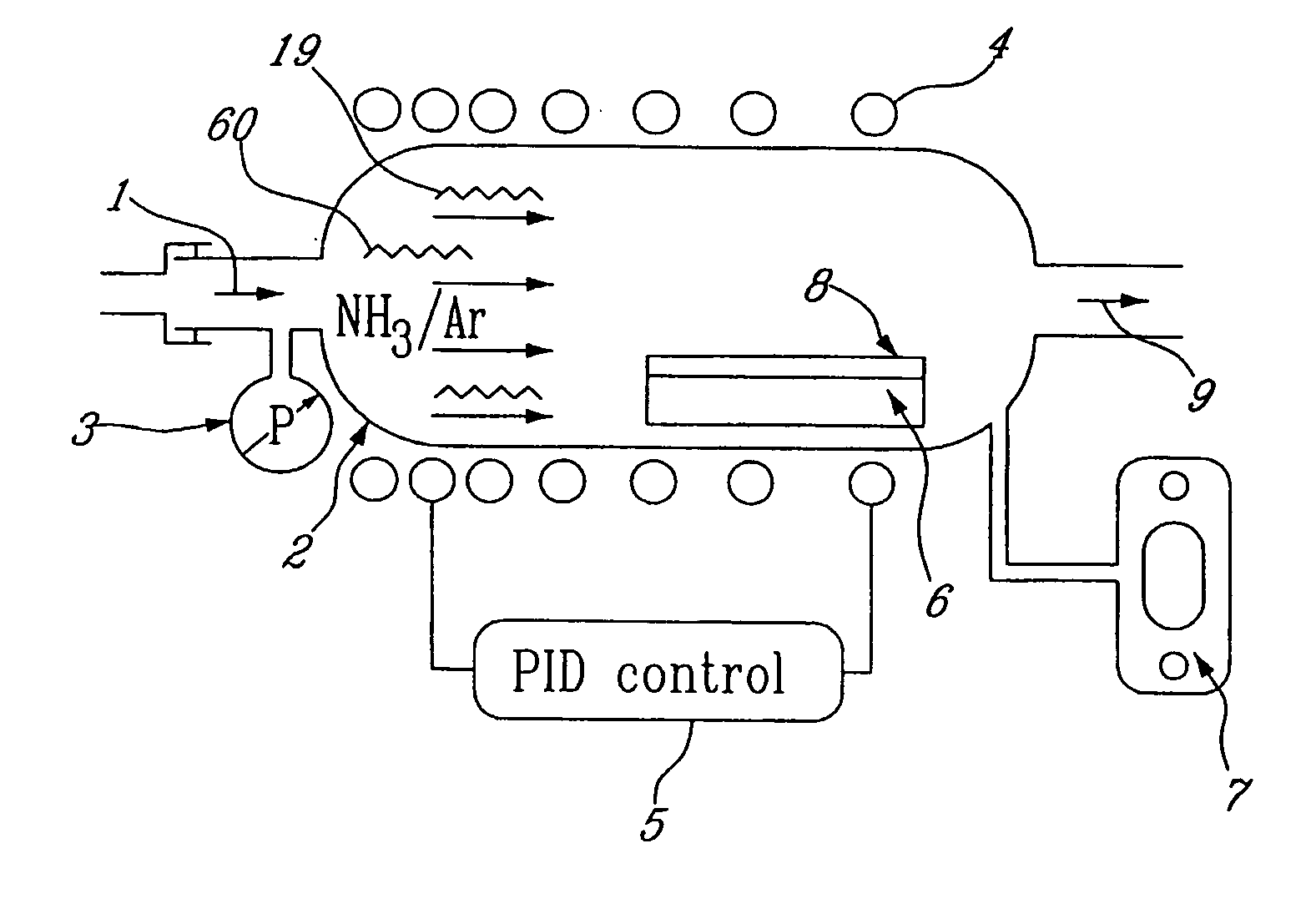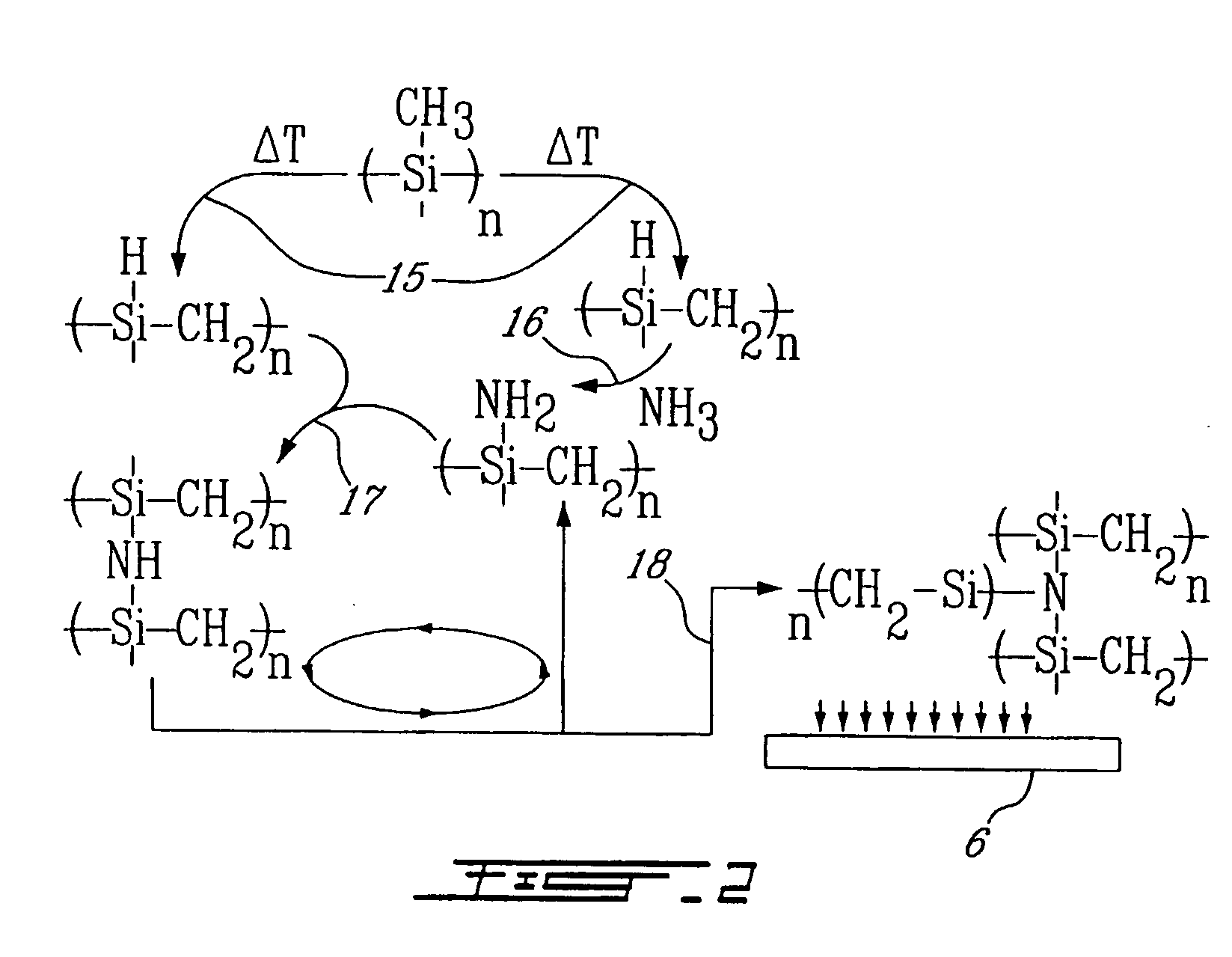Ceramic thin film on various substrates, and process for producing same
a technology of ceramic thin film and substrate, applied in the direction of crystal growth process, chemical vapor deposition coating, coating, etc., can solve the problems of contaminated film, increased disorder of si—c network, increased shrinkage and outgassing phenomena,
- Summary
- Abstract
- Description
- Claims
- Application Information
AI Technical Summary
Benefits of technology
Problems solved by technology
Method used
Image
Examples
example 1
Use of Polysilanes as PA-CVD Precursors to n-type Semiconductor a-SiC.
[0094] The anticeramic yield is optimized with respect to the average molecular weight and the polydispersity of the polysilane raw material. In the first step, an appropriate time-dependent temperature gradient is programmed in the furnace, so that quantitative polycarbosilane formation is promoted. Possible ranges for the gradients are 1-10 Kmin−1 and 3-50 Kcm−1 in a 2 inch / 150 cm horizontal quartz reactor (11). A second step involves polycarbosilane pyrolysis that may be coupled with a nitrogen-doping process, via a carefully monitored (flow, pressure (3), and FT-IR (7)) reaction with electronic-grade ammonia (12), at a partial pressure level of 10−6-10−1 torr in a UHP-Ar (or N2) carrier flow. The resulting polymeric gaseous species (17,18) are transported in the deposition zone (13), where they are desublimed onto the substrate (6) that can be placed in a horizontal, vertical or a tilted position, and can be ...
example 2
Use of Polysilanes as PA-CVD Precursors for the Synthesis of Thin Films of Passivating SiOxCy-glasses
[0095] Silicon oxycarbide (SiOxCy) is an amorphous metastable phase wherein the silicon atoms are bonded to oxygen and carbon simultaneously. In silicon oxycarbides, high temperature properties and chemical stability have been reported, exceeding those of ordinary vitreous silica. Silicon oxycarbide materials have also the potential for use in a variety of protective applications within the semiconductor industry. Using PA-CVD technique, silicon oxycarbides of various compositions have been deposited on highly resistive single crystal silicon wafers, using different conditions to vary the oxygen content in the films. The anticeramic yield is optimized with respect to the average molecular weight and the polydispersity of the polysilane raw material.
[0096] In the first step, an appropriate time-dependent temperature gradient is programmed in the furnace to enhance quantitative polyc...
example 3
Use of Polysilanes as PA-CVD Precursors to Dielectric or Passivating a-SixNy Thin Films
[0099] The anticeramic yield is optimized with respect to the average molecular weight and the polydispersity of the polysilane raw material. An appropriate time-dependent temperature gradient is programmed in the furnace, so that quantitative polysilazane formation is promoted. Possible ranges for the gradients are 1-5° K. min−1 and 3-50° K. cm−1 where the temperature increases (11) in a 2 inch / 150 cm horizontal quartz reactor (2). A second step involves pyrolysis of the polysilazane in the reaction zone (12) in FIG. 1 where the temperature is relatively constant. This step may be optionally followed by a transamination processes induced directly in the deposition zone (13), via a carefully monitored (flow, pressure—parameters (3) and PID temperature parameters (5) where P=1-25, I=10-250, and D=0.1-10) reaction under pure electronic-grade gaseous ammonia introduced in the temperature zone (11), ...
PUM
| Property | Measurement | Unit |
|---|---|---|
| temperature | aaaaa | aaaaa |
| temperature | aaaaa | aaaaa |
| temperature | aaaaa | aaaaa |
Abstract
Description
Claims
Application Information
 Login to View More
Login to View More - R&D
- Intellectual Property
- Life Sciences
- Materials
- Tech Scout
- Unparalleled Data Quality
- Higher Quality Content
- 60% Fewer Hallucinations
Browse by: Latest US Patents, China's latest patents, Technical Efficacy Thesaurus, Application Domain, Technology Topic, Popular Technical Reports.
© 2025 PatSnap. All rights reserved.Legal|Privacy policy|Modern Slavery Act Transparency Statement|Sitemap|About US| Contact US: help@patsnap.com



